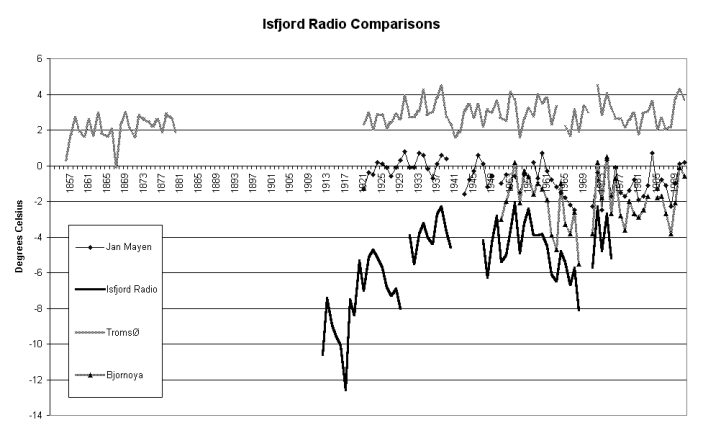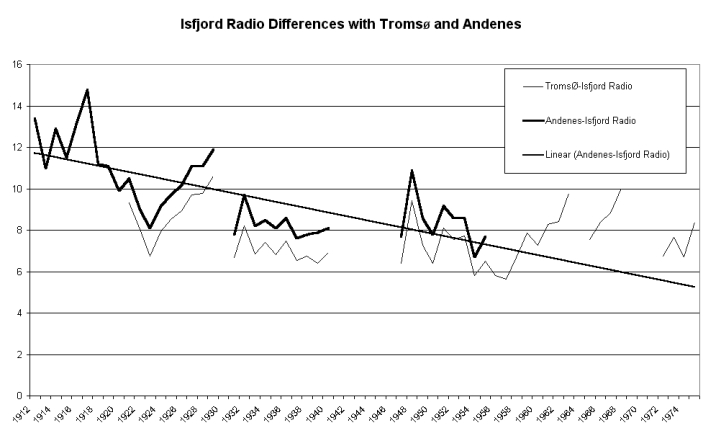
Isfjord Radio Compared to TromsØ, Bjornoya, Jan Mayen
The first review is of a Norwegian station on Spitzbergen (Svalbard), Isfjord Radio. The graphic below shows the temperature record in degrees Celsius for Isfjord Radio together with other relevant records, all from the CRU dataset. The non-climatic cold anomaly in early years has caused a large artificial warming trend. In the CRU reports they give various station details including other stations that each record may have been compared to to check its validity.
In this case CRU compared Isfjord Radio to TromsØ ( a town in northern Norway ) and Bjornoya a station on the small, Bear Island between Spitzbergen and Norway. As the graph shows pre WWII TromsØ and Isfjord show no similarity at al. Another nearby record on Jan Mayen Island, about the same distance from Isfjord as TromsØ, shows that TromsØ and Jan Mayen are similar in trend, suggesting that it is Isfjord that is the odd man out. Bjornoya is too short a record to cast light on the problem pre WWII cold anomaly in Isfjord Radio.
The question has to be asked as to why you would specify the Isfjord / TromØ comparison and then ignore the obvious huge difference in trends. Temperature recording stations are designed to gather data to assist in weather forecasting, not to build century scale data series to detect tiny fluctuations in climate. It is well known that equipment deterioration and site changes can alter temperature readings to a much larger extent than the magnitude of global warming. Weather services sometimes keep a station log where notes may cast light on the reason for jumps and non-climatic trends in data. In this case the warming is so large that it defies belief that it could be due to a local climatic warming. Breaks in a record should alert the researcher to possible equipment or site changes.
Isfjord Radio failed quality control checks by V2 GHCN in 31 monthly data points over the years 1912, 14, 15, 16, 17, 18, 19, 24, 27, 29, 30, 31, & 1979. I am not saying that what the GHCN team did has to prevail over CRU but the V2 GHCN is the most comprehensive global dataset we have at present. In their quality control checks the V2 GHCN team has filtered out much non-climatic errant data but there are plenty of small inhomogeneities to be seen as we will see in later pages.

Comment
Professor Phil Jones has sent in the following.
"Isfjord Radio on Spitzbergen : The paper by
Hanssen-Bauer and Forland of the Norwegian Met. Service
(DNMI) in Climate Research 10, 143-153 is worth reading. In a
sentence they conclude that the temperature record is OK and can
be explained by circulation changes and sea-ice changes.
Changes in sea-ice mean that your comparisons with Bear
Island will only be
informative some of the time. In the 1910s Spitzbergen had much
greater sea-ice extent than for any time since. Changes in sea
ice (either reductions or expansions) dramatically change surface
temperatures - this can be seen in many other regions of the
world, esp the Antarctic Peninsula region over the last 40
years. The big increases in temperature there are
principally due to less sea ice. Variability of temps there
is the highest anywhere in the world because of the strong
sea-ice influence.
Obviously, sea-ice influenced sites will not have at
certain times, the same sphere of influence when there is
'normal' amounts of sea ice, but then this one
station on Spitzbergen only influences a single grid box."
Reply by Warwick Hughes
The central principle behind the global temperature trend compilations carried out by Professor Jones and CRU in the mid 1980's is comparison between neighbouring station data. The CRU Northern Hemisphere compilation Jones et al 1985 looked at 2666 stations, so clearly the project would have taken many more years to complete if the sort of greater detail climatology involved in the justification of Isfjord Radio was applied to every station, as elementary scientific principles would dictate.
Station notes in Jones 1991 show Isfjord Radio was compared with Bjornoya 1951-79 and TromsØ, 1912-79. TromsØ has a data gap precluding any differences prior to 1921 and in that detail the station notes for Isfjord Radio mislead the reader because no comparison with TromsØ pre-1921 was possible. However Andenes which is near TromsØ and has full data 1868-1955 could have been used as shown in the chart below.

On the basis of the Andenes and TromsØ
differences, the wild variations and erratic warm drift in
homogeneity between these stations should have been reason
for Isfjord Radio to be rejected. No notes or
reference to retaining Isfjord Radio as some special case,
are to be found in Jones et al 1991 and its retention in the
database represents a touching faith in geostatistics outliers.
Looking at the idea that ice melting could be the reason for the rapid warming in Spitzbegen 1912-1923, consider the global map of Jones 1994 temperature anomalies 1901-1996 in Karl 1998 and we see the the Svalbard (Spitzbergen) grid box warms at about 4 degrees, twice that of any other grid box on the planet.
If this rapid warming was due to ice melting, common
sense tells us it must have happened somewhere else. A huge
magnitude rapid warming such as this could not just occur in a 5
degree grid box. Look at the high northern latitudes on the Karl
1998 map and there are no other comparable examples despite a
good scattering of stations above the Arctic Circle.
This case is a manifestation of the lapse in critical standards
in climatology, which is after all a very new and ( up to
the advent of the IPCC ), very small science.
Just to end up with an example from the real world of mineral
exploration known well to the writer. Geochemical and geophysical
data which are the mainstay of the orebody discovery process are
littered with outlier values that if targeted with drilling would
rapidly bankrupt any mineral exploration company.
Exploration geologists every day have to deal with filtering out
spurious signals from their geostatistics so that scarce
exploration funding is not wasted. In the
current world of climatology, large amounts of greenhouse
industry controlled taxpayer funded research grants will
inevitably dull essential scientific scepticism.
You saw it all first here.
Posted, 20, May, 2000, updated with comment, 22, July 2000
© Warwick Hughes, 2000
globalwarming-news.com
Back to Cities List
Back to Front Page